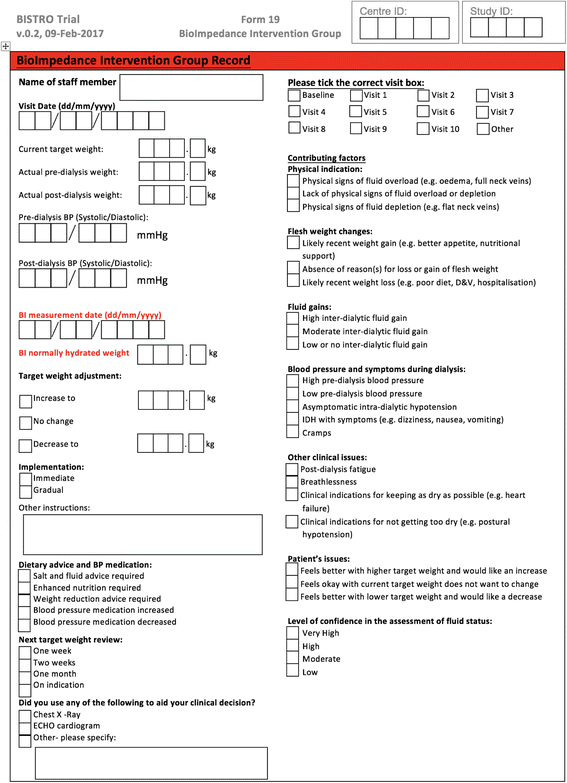Rationale and design of BISTRO: a randomized controlled trial to determine whether bioimpedance spectroscopy-guided fluid management maintains residual kidney function in incident haemodialysis patients
- PMID: 28441936
- PMCID: PMC5405466
- DOI: 10.1186/s12882-017-0554-1
Rationale and design of BISTRO: a randomized controlled trial to determine whether bioimpedance spectroscopy-guided fluid management maintains residual kidney function in incident haemodialysis patients
Abstract
Background: Preserved residual kidney function (RKF) and normal fluid status are associated with better patient outcomes in incident haemodialysis patients. The objective of this trial is to determine whether using bioimpedance technology in prescribing the optimal post-dialysis weight can reduce the rate of decline of RKF and potentially improve patient outcomes.
Methods/design: 516 pateints commencing haemodialysis, aged >18 with RKF of > 3 ml/min/1.73 m2 or a urine volume >500 ml per day or per the shorter inter-dialytic period will be consented and enrolled into a pragmatic, open-label, randomized controlled trial. The intervention is incorporation of bioimpedance spectroscopy (BI) determination of normally hydrated weight to set a post-dialysis target weight that limits volume depletion, compared to current standard practice. Clinicians and participants will be blinded to BI measures in the control group and a standardized record capturing management of fluid status will be used in all participants. Primary outcome is preservation of residual kidney function assessed as time to anuria (≤100 ml/day or ≤200 ml urine volume in the short inter-dialytic period). A sample size of 516 was based upon a cumulative incidence of 30% anuria in the control group and 20% in the treatment group and 11% competing risks (death, transplantation) over 10 months, with up to 2 years follow-up. Secondary outcomes include rate of decline in small solute clearance, significant adverse events, hospitalization, loss of vascular access, cardiovascular events and interventions, dialysis efficacy and safety, dialysis-related symptoms and quality of life. Economic evaluation will be carried out to determine the cost-effectiveness of the intervention. Analyses will be adjusted for patient characteristics and dialysis unit practice patterns relevant to fluid management.
Discussion: This trial will establish the added value of undertaking BI measures to support clinical management of fluid status and establish the relationship between fluid status and preservation of residual kidney function in incident haemodialysis patients.
Trial registration: ISCCTN Number: 11342007 , completed 26/04/2016; NIHR Portfolio number: CPMS31766; Sponsor: Keele University.
Keywords: Bioimpedance; Body compostion; Fluid management; Fluid status; Haemodialysis; Health economics; Residual kidney function.
Figures


References
-
- Bargman JM, Thorpe KE, Churchill DN. Relative contribution of residual renal function and peritoneal clearance to adequacy of dialysis: a reanalysis of the CANUSA study. J Am Soc Nephrol. 2001;12:2158–2162. - PubMed
-
- Termorshuizen F. Relative contribution of residual renal function and different measures of adequacy to survival in hemodialysis patients: an analysis of the Netherlands Cooperative Study on the adequacy of dialysis (NECOSAD)-2. J Am Soc Nephrol. 2004;15:1061–1070. doi: 10.1097/01.ASN.0000117976.29592.93. - DOI - PubMed
Publication types
MeSH terms
Grants and funding
LinkOut - more resources
Full Text Sources
Other Literature Sources
Medical

